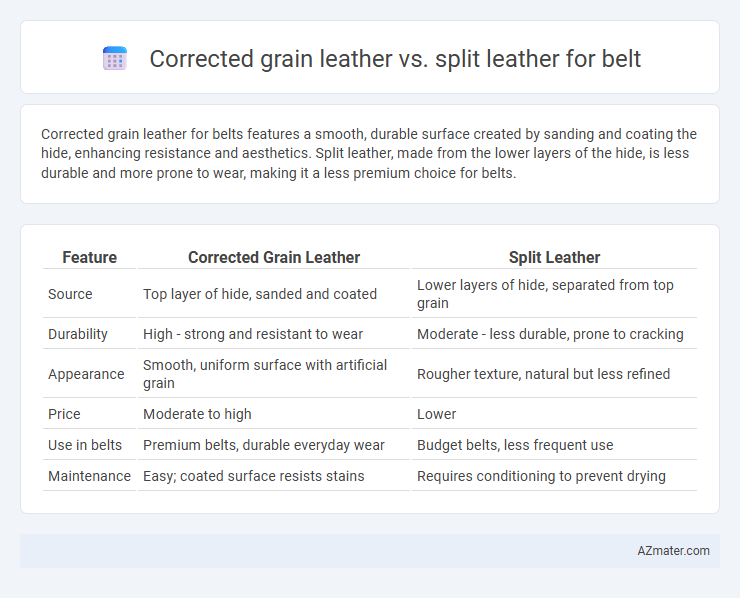Corrected grain leather for belts features a smooth, durable surface created by sanding and coating the hide, enhancing resistance and aesthetics. Split leather, made from the lower layers of the hide, is less durable and more prone to wear, making it a less premium choice for belts.
Table of Comparison
| Feature | Corrected Grain Leather | Split Leather |
|---|---|---|
| Source | Top layer of hide, sanded and coated | Lower layers of hide, separated from top grain |
| Durability | High - strong and resistant to wear | Moderate - less durable, prone to cracking |
| Appearance | Smooth, uniform surface with artificial grain | Rougher texture, natural but less refined |
| Price | Moderate to high | Lower |
| Use in belts | Premium belts, durable everyday wear | Budget belts, less frequent use |
| Maintenance | Easy; coated surface resists stains | Requires conditioning to prevent drying |
Introduction to Corrected Grain and Split Leather
Corrected grain leather features a buffed surface with an applied finish to mask imperfections, enhancing durability and uniform appearance ideal for belts. Split leather derives from the lower layers of a hide, exhibiting a rougher texture and generally less strength but can be treated for budget-friendly belt options. Choosing between corrected grain and split leather depends on the balance of aesthetic appeal, durability, and cost for belt manufacturing.
Understanding Corrected Grain Leather
Corrected grain leather, used in belt production, undergoes surface sanding to remove imperfections before applying a pigment coating, resulting in a uniform, durable finish ideal for fashion belts. Unlike split leather, which is made from the fibrous lower layer of hides and often lacks strength, corrected grain leather maintains the toughness of top-grain while enhancing appearance through correction processes. This combination makes corrected grain leather belts more resistant to wear and stains compared to split leather options.
What Is Split Leather?
Split leather is derived from the bottom layer of a cowhide after the top grain is separated, resulting in a more fibrous and less durable material compared to corrected grain leather. Corrected grain leather undergoes sanding and embossing to mask imperfections, providing a smoother surface and enhanced durability suitable for belts. Split leather belts are typically more affordable but may lack the strength and refined appearance found in corrected grain leather belts.
Key Differences Between Corrected Grain and Split Leather
Corrected grain leather is made from the top layer of the hide with an artificial grain texture applied to hide imperfections, offering higher durability and a more polished appearance ideal for belts. Split leather, derived from the lower layers of the hide, lacks the natural grain surface and is typically more porous and less durable, making it less suited for long-lasting belt wear. Key differences include corrected grain leather's smooth finish and strength versus split leather's rougher texture and reduced resistance to wear.
Durability: Which Leather Lasts Longer for Belts?
Corrected grain leather features a top layer of the hide that has been sanded and treated, making it more resistant to wear and scratches, which enhances its durability for belts. Split leather, derived from the lower layers of the hide, is generally less durable and more prone to stretching or tearing over time. Therefore, corrected grain leather typically lasts longer and maintains its structural integrity better than split leather for belt applications.
Appearance and Texture Comparison
Corrected grain leather exhibits a smooth, polished surface created by sanding and coating the hide, providing a more refined and uniform appearance ideal for belts seeking a sleek look. Split leather, derived from the fibrous lower layer of the hide, has a rougher texture with less natural grain, resulting in a matte finish that can feel stiffer and less durable compared to corrected grain. The visual appeal of corrected grain leather belts is typically higher due to the enhanced surface treatment, while split leather belts offer a more rugged or casual aesthetic but may show quicker wear.
Comfort and Flexibility in Daily Use
Corrected grain leather offers enhanced comfort and better flexibility for belts due to its smoother surface and improved durability from buffing and coating processes. Split leather, derived from the lower layers of the hide, tends to be stiffer and less breathable, potentially causing discomfort during prolonged wear. For daily use, belts made from corrected grain leather provide a superior balance of softness, flexibility, and long-lasting comfort compared to split leather options.
Price Differences and Value for Money
Corrected grain leather belts generally cost more than split leather belts due to their higher durability, smoother finish, and enhanced resistance to wear. Split leather belts, made from the lower layers of the hide, offer a budget-friendly option but tend to have lower longevity and surface quality. Investing in corrected grain leather provides better value for money as it combines strength, appearance, and lifespan, justifying the higher price point over split leather belts.
Maintenance and Care Requirements
Corrected grain leather belts require regular cleaning and periodic conditioning to maintain their smooth surface and prevent cracking, as their top layer is sanded and refinished. Split leather belts, being made from the lower layers of the hide, are more porous and prone to wear, necessitating more frequent moisturizing and protection against water damage to extend their lifespan. Proper maintenance of both types involves avoiding prolonged exposure to moisture and direct sunlight to preserve the leather's durability and appearance.
Which Leather Is Best for Your Belt?
Corrected grain leather offers a durable and smooth surface with a protective finish, making it ideal for belts that require a polished look and resistance to wear. Split leather, derived from the lower layers of the hide, is more porous and less durable but often used for affordable belts with suede-like texture. For a balance of longevity, appearance, and strength, corrected grain leather is generally the best choice for quality belts.

Infographic: Corrected grain leather vs Split leather for Belt
 azmater.com
azmater.com